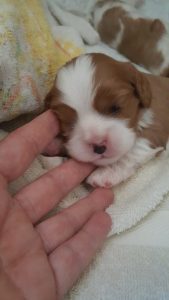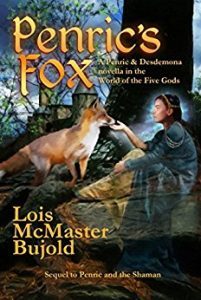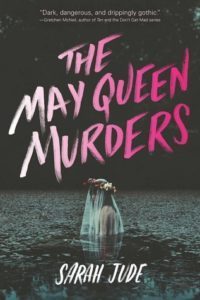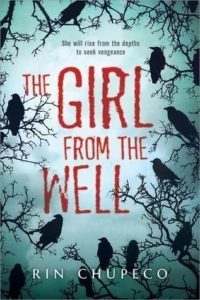Rachel Neumeier's Blog, page 251
October 24, 2017
Interesting News Tuesday
Sometimes we do definitely live in a science fiction universe.
As evidence, this: TastyFloats: A Levitating Food Delivery System
Two phased arrays of low-cost ultrasonic transducers opposite each other form a standing wave of ultrasound between them, and very small amounts of liquids and solids can be suspended in the nodes of the wave. Changing the phase can move these nodes in three dimensions, pulling the contents along with it, and allowing the materials to be transported in 3D space as long as they stay between the arrays.
Doing this with food is surprisingly tricky, because food is so variable. The ultrasound will impart heat to whatever it’s levitating, causing alcohols to begin to evaporate. High density foods (like cheeses) require more power than low density foods. And the overall system has to be tuned to adapt to foods of different weights to be able to properly control their respective exit trajectories so that they land on just the right spot on your tongue.
What could possibly be more worthwhile than technology that lets you sit on your hands while food is levitated to your mouth? Right?
Meanwhile, elucidating the history of living things: Scientists track the brain-skull transition from dinosaurs to birds
The dramatic, dinosaur-to-bird transition that occurred in reptiles millions of years ago was accompanied by profound changes in the skull roof of those animals — and holds important clues about the way the skull forms in response to changes in the brain… “What this implies is that the brain produces molecular signals that instruct the skeleton to form around it, although we understand relatively little about the precise nature of that patterning.”
Bhullar added: “Ultimately, one of the important messages here is that evolution is simpler and more elegant than it seems. Multiple seemingly disparate changes — for instance to the brain and skull — could actually have one underlying cause and represent only a single, manifold transformation.”
Quite wonderful. I’ve always had a special fondness for the feathered dinosaurs and early birds. Transitional stages are so fascinating.
On a much broader scale: Half of the universe’s missing normal matter has been found
Astronomers have a problem when it comes to the mass in the universe; a lot of it is missing. You may know about dark matter, the enigmatic substance thought to make up 27% of the universe, but this isn’t the only mysterious absence. When it comes to normal matter; the stuff we are made of including protons, neutrons and electrons, there’s also a chunk missing. In fact, models of the universe hint there should be about twice as much matter as we can see. This is called the missing baryons problem.
Now, two papers have come out suggesting we may have found half of this missing chunk, in huge stretches of hot, diffuse gas that hold galaxies together.
I have no opinion on astrophysical problems, since I have no background in anything related, but this is interesting. I do wonder how “hot diffuse gas” can “hold galaxies together.” Maybe this be gravitational, even though these clouds of gas are so diffuse?
Please Feel Free to Share:









October 23, 2017
We live in different worlds
At Slate Star Codex, a long (very long) but fascinating (very fascinating) post about the different words we inhabit.
A few years ago I had lunch with another psychiatrist-in-training and realized we had totally different experiences with psychotherapy.
We both got the same types of cases. We were both practicing the same kinds of therapy. We were both in the same training program, studying under the same teachers. But our experiences were totally different. In particular, all her patients had dramatic emotional meltdowns, and all my patients gave calm and considered analyses of their problems, as if they were lecturing on a particularly boring episode from 19th-century Norwegian history.
I’m not bragging here. I wish I could get my patients to have dramatic emotional meltdowns. As per the textbooks, there should be a climactic moment where the patient identifies me with their father, then screams at me that I ruined their childhood, then breaks down crying and realizes that she loved her father all along, then ???, and then their depression is cured. I never got that. I tried, I even dropped some hints, like “Maybe this reminds you of your father?” or “Maybe you feel like screaming at me right now?”, but they never took the bait. So I figured the textbooks were misleading, or that this was some kind of super-advanced technique, or that this was among the approximately 100% of things that Freud just pulled out of his ass.
And then I had lunch with my friend, and she was like “It’s so stressful when all of your patients identify you with their parents and break down crying, isn’t it? Don’t you wish you could just go one day without that happening?”
This experience leads to a more generalized investigation about the extraordinarily different experiences of life that people accumulate, including experiences of bias:
Sometimes I write about discrimination, and people send me emails about their own experiences. Many sound like this real one (quoted here with permission) from a woman who studied computer science at MIT and now works in the tech industry:
In my life, I have never been catcalled, inappropriately hit on, body-shamed, unwantedly touched in a sexual way, discouraged from a male-dominated field, told I couldn’t do something because it was a boy thing, or suffered from many other experiences that have traditionally served as examples as ways that women are less privileged. I have also never been shamed for not following gender norms (e.g. doing a bunch of math/science/CS stuff); instead I get encouraged and told that I’m a role model. I’ve never had problems going around wearing no make-up, a t-shirt, and cargo pants; but on the rare occasion that I do wear make-up / wear a dress, that’s completely socially acceptable…Hopefully my thoughts/experiences are helpful for your future social justice based discussions.
Other times they sound like the opposite. I don’t have anyone in this category who’s given me permission to quote their email verbatim (consider ways this might not be a coincidence), but they’re pretty much what you’d expect – a litany of constantly being put down, discriminated against, harassed, et cetera, across multiple jobs, at multiple companies, to the point where they complain it’s “endemic” (I guess I can quote one word) and that we need to reject a narrative of “a few bad apples” because really it’s a problem with all men to one degree or another…. These people don’t just show up in my inbox. Some of them write articles on Slate, Medium, even The New Yorker, discussing not just how they’ve never experienced discrimination, but how much anger and backlash they’ve received when they try to explain this to everyone else. And all of them acknowledge that they know other people whose experiences seem to be the direct opposite.
The whole post is very much worth reading, but I found this section the most intriguing. If you have time and find this sort of thing at all interesting, please click through and read the whole thing.
Please Feel Free to Share:









Myers-Briggs, the blog edition
As you all know, I enjoy all the variants on the Myers-Briggs personality test. Here’s one for book bloggers, from Charlotte at Charlotte’s Library.
I am … I’m sure this won’t surprise you … INTJ, as always.
However, I was a weaker N than I’d have expected. A bit wishy-washy for J vs P as well, but that’s more expected.
Please Feel Free to Share:









October 20, 2017
Puppies!
On October 4th, this:
I was lucky in the timing! World Fantasy is November 2-5, which is fine, because by then the puppies will be four weeks old and just hitting the very easiest period: old enough to be safe from chills, young enough you needn’t worry much about weaning or at all about housetraining. If Honey had come into season just two weeks later, I’d either have had to skip breeding her or skip the WFC. As it is, everything should be fine, barring wild emergencies.
The puppies are actually two weeks old in this picture. At this point, the boys are well over a pound, the girls right around a pound. The boys started out about seven and a half oz, the girls about five and a half oz. (This is just random, not a sex-related thing. It has to do with quality of the placental connection and the uterine environment, and in this case the girls happened to wind up smaller. One can’t estimate adult size from birth weights or weights at two weeks.)
The little girls opened their eyes at 13 days; Boy 1 at 14 days; and Boy 2, a real little hippo, at 16 days, so I guess we can conclude that size doesn’t influence time of eyes opening. The puppies don’t look much like Cavaliers yet, but they are starting to look like puppies! So now that I’m sure they are thriving, I’m willing to introduce the “L” litter.

Boy 1

Both boys

Girl 1

Girl 2 (top of the pile)
The biggest reason for excitement: FOUR! That may be an average litter size for Cavaliers, but considering my own personal average litter size is closer to 1.7, I’m pretty darn happy to have four healthy puppies.
The only reason for disappointment: only one puppy is really well marked, and alas, he’s a boy. I so did not want to keep another boy, but, well, I am leaning that way at the moment. Neither girl has great markings, with Girl 1 having an unusually dark face:

Girl 1
Since I’m not crazy about the girls’ face markings, I’ll be taking a good look at them both in about seven weeks and making a decision about which to keep solely on type and structure. Though they will change a lot as they grow and their heads take on a proper shape and their faces gain expression — at that point I may find that the markings on Girl 1 actually are kind of cute.
Most breeder-judges do not look a lot at markings, by the way, on the grounds that if you don’t care for a particular dog’s markings, well, they won’t be there in the next generation. But there’s no question that markings are bound to be a deal-breaker when it comes to a hard choice between two dogs that are about equal in other ways.
Meanwhile, while waiting for the puppies to grow up a bit more: “L” names …
We had a pretty snazzy eclipse here. So how about:
Lunar Eclipse
Lunar Madness
Luna Moth
Lavender Moon
You recall that all of these would have “Anara” in front because that is the kennel name.
On the other hand, the mother is Anara Honeysuckle Rose and Kimmie, a full sister, is Anara Kimberlyn Rose, so keeping “Rose” in the name would add extra charm if I wound up keeping one of the girls. In that case, maybe lose the moon theme as a theme and go with:
Lunar Eclipse
Leonidas
Lapis Lazuli
Lavender Rose
Or possibly choose some names that include an “L”, but not as the first letter. For example:
Silent Lucidity
Fiat Lux
And then add random names that just sound good as show names:
Love Affair
Llewellyn Rose
Well, I shall muse upon it. It does help to have the show name suggest the callname. Like anything with Luna or Moon for a girl could be “Luna.” Fiat Lux could easily just be “Lux.” Leonidas easily shortens to “Lon.” What would you call a boy puppy if you named him Lunar Eclipse, though?
Please Feel Free to Share:









October 19, 2017
Historical research
Here’s a good post at Writer UnBoxed: Historical Novels—Your Research To-Do List.
I believe this post caught my eye because a commenter here recently mentioned how annoyed she gets when characters in historical novels have anachronistic names.
This post is about a lot more than that, though it *is* a bit amusing to think of a Regency with a protagonist named, say, Brittney.
I particularly like this suggestion:
Read historical fiction…carefully. An obvious instinct is, “How did other authors do this?” But remember, novelists don’t always get things right. Excellently researched novels are a complement to your research, not a substitution. They are fiction, after all. Unless…
Read novels that were once contemporary. My setting was 1918. So I read and reread Fitzgerald, Hemingway and others who lived then and wrote novels that were contemporary at the time.
This strikes me as perfect advice. I like nonfiction, but I read a lot more fiction and I definitely draw on, say Gillian Bradshaw, for descriptions of architecture. Not for historical settings, of course, but Bradshaw is a great resource for fantasy settings as well. I’d be inclined toward historical novels if I were writing one — and the suggestion to let some of those be contemporary-at-the-time novels is definitely one I would follow.
Right at the moment, a WIP that I’m making some actual progress on is sort of historical. It’s a (very) alternate Regency-ish setting. So I am indeed drawing on Regency novels for setting details, but at the same time I don’t have to get everything right because as I say, (very) alternate. Strongly Regency flavored, shall we say, rather than an actual Regency setting as such.
Still, these suggestions remain good ones. Also, I trust I will avoid naming anybody anything too modern! Not too much a concern because most characters have somewhat odd names anyway, even by the standards of their own society.
Please Feel Free to Share:









Penric novella
Hey, just noticed this from LMB via Goodreads:
I am pleased to report I have finished the first draft of a new Penric & Desdemona novella, sequel to “Mira’s Last Dance”. Title is decided all but one vowel — I’ll add it when my aesthetic waffling concludes. About 44,980 words.
Later: Having spent the whole last day wrestling with one. dratted. vowel., title has finalized as:
“The Prisoner of Limnos”
Good to know this one is a direct sequel to “Mira’s Last Dance,” because (a) that one really needs a sequel, and (b) “Penric’s Fox” wasn’t it.
I thought the latter was pleasant enough, but minor and in no way a substitute for a novella that actually moves the Penric story forward. Despite the fact that I am very fond of literary foxes.
Please Feel Free to Share:









October 18, 2017
Intriguing floating “map” of literature
I typed in Lois McMaster Bujold.
The site says “What else do readers of Lois Mcmaster Bujold read? The closer two writers are, the more likely someone will like both of them. Click on any name to travel along.”
Some authors floating near Bujold whom I haven’t read (or not much): Jim Butcher, Glen Cook.
Some authors ditto whom I just love: Dorothy Dunnett, Georgette Heyer — how interesting that the site doesn’t care if they’re SFF authors or other genre authors!
Now let me just click over here to CJ Cherryh, also close to Bujold … okay, after the screen settles down, I can see that Frederick Pohl is generally favored by Cherryh fans. Not by me particularly. Sharon Shinn as well, which is interesting — I love both Cherryh and Shinn, but I would have said they’re quite different. Clicking on Sharon Shinn . . . oh, look, here’s Nicola Griffith way over on the edge. Oh, and here’s Rosemary Kirstein …
Very interesting, oddly compelling site for such bare-bones graphics. The way the names swirl around like minnows in a pond definitely has something to do with that. I encourage you all to click through and try this out.
Please Feel Free to Share:









October 17, 2017
Are you tired of dystopias yet?
Here’s an interesting post at The Christian Science Monitor: ‘Blade Runner 2049’: Why some science fiction writers are tired of dystopias
Recent dystopian blockbusters seem to be jostling in a grim race to be the first to reach the seventh circle of hell in Dante’s “Inferno.” But some science-fiction writers are tired of the sorts of pessimistic futures depicted in movies and TV shows such as “The Hunger Games,” “Mad Max: Fury Road,” “Black Mirror,” and “The Handmaid’s Tale.”
In response, influential authors Neal Stephenson, Cory Doctorow, David Brin, and Kim Stanley Robinson argue that futuristic fiction should, instead, offer an inspiring outlook about mankind’s ability to shape its destiny.
I basically never get tired of anything, because I don’t ever seem to read enough of any one subgenre to burn out on it. Well, except grimdark, which I burned out on REAL fast, essentially as soon as I recognized the category. But fundamentally, no, if a new take on a dystopia is well written, I’ll be happy to give it a try.
But to me, dystopias don’t seem fundamentally pessimistic.
Wait, I mean young adult dystopias don’t seem fundamentally pessimistic.
In YA dystopian fiction, the horrible repressive government always gets destroyed, thus laying the groundwork for a better future. (Are there exceptions? Let me know and I will avoid those.) YA dystopias are thus fundamentally optimistic and The Hunger Games does not belong in the same sentence as The Handmaid’s Tale. Really, I don’t know how the author of this post — Stephen Humphries — could have missed this obvious distinction between YA and adult dystopian fiction.
On the other hand, Humphries is in fact actually framing a broader argument about literature and society, and about pessimistic versus optimistic visions of the future:
But perhaps the debate over utopian versus dystopian fiction should be reframed. A more helpful distinction might be the difference between nihilism and existentialism in science fiction. Amid doom-and-gloom scenarios, does the hero or heroine have agency and an ability to win the day?
And there you go, there is the fundamental distinction between grimdark and everything else, rather than between dystopia and everything else.
Humprhies seems to be lacking some of the background categories — dark vs grimdark, for example — which would make it easier to frame thoughts on this topic. This is true even though opinions differ about what delineates various categories of SFF. Still, the post is worth a look if you have a minute to click through and read the whole thing.
Please Feel Free to Share:









Good News Tuesday
This week, as so often, a focus on medical good news. I believe I’ll start trying to alternate: medicine vs everything else.
This first one is pretty darned good:
Arming Bodies with CRISPR to Fight Huntington’s Disease
Huntington’s is so awful, and there has never been anything much we could do about it. Now: In a study published in August, Yeo and his colleagues used CRISPR-Cas9 to destroy errant repeats in RNA sequences. When tested in the lab, Yeo’s CRISPR tool obliterated 95 percent or more of these RNA knots in cells harboring Huntington’s disease and a type of ALS. … The researchers also tested the approach on a form of inherited muscular dystrophy, called myotonic dystrophy. They were able to eliminate 95 percent of faulty RNAs in muscle cells taken from patients. After they applied CRISPR, the once-diseased cells resembled healthy ones. Yeo thinks more than 20 genetic diseases that are caused by toxic RNA repeats could potentially be treated this way.
Onward!
Huntington’s and similar conditions have been problems for ages, but “superbugs” are of course a modern phenomenon. I’m waiting for therapies that don’t involve antibiotics to be developed, since that seems like the most promising avenue to deal with drug-resistant bacteria. Here’s an in-between type of therapy: a way of boosting the performance of older antibiotics:
Light-Activated Nanoparticles Help Fight Drug-Resistant Superbugs
Our strongest antibiotics are increasingly defenseless against the nastiest bacterial infections, but the use of new light-activated nanoparticles could give those old drugs a fighting chance. In a paper published today in Science Advances, researchers reported that quantum dots—light-activated semiconductor nanoparticles—when engineered at a particular size can sneak into bacteria, disrupt their cellular processes, and make them more susceptible to antibiotics.
The discovery could breathe new life into old antibiotics, says Anushree Chatterjee, a chemical and biological engineer at the University of Colorado Boulder, who co-authored the report. It also exemplifies how electrical engineering can be used to address problems typically approached purely though medicine.
Next, a very science-fiction-y wound treatment, although I question the use of the word “heals” here:
Injectable glue heals wounds in seconds
The injectable glue, MeTro, is based on a naturally occurring protein called tropaelastin. It is applied directly to the wound and is then activated with UV light to form a complete seal, eliminating the need for staples or stitches. Its elasticity means it’s designed to work well on shape-changing internal organs like the lungs and heart.
A study published in journal Science Translational Medicine showed the glue quickly and successfully sealed incisions in the arteries and lungs of rodents and the lungs of pigs.
Of course there’s quite a difference between “healing” and “sealing,” but hey.
And speaking of misleading headlines, this one is probably a trifle overstated:
But still, it sounds pretty cool:
If you had seen Lisa Kulik and her husband strolling the grounds of the University of Southern California’s Eye Institute last summer, you would have thought nothing of it. But for Kulik, that simple walk around the campus was “a miracle.” Blind for more than two decades from an inherited eye disease called retinitis pigmentosa, Kulik was seeing again — clearly enough to make out the sidewalk and the grassy edge — thanks to a sophisticated microchip implanted in one of her eyes.
The device, called the Argus II, is just one of a growing number of bold new approaches to treating blindness, offering hope to the millions of mostly older Americans in danger of losing their sight from macular degeneration, glaucoma, diabetic retinopathy and other eye diseases.
The reason this can’t possibly be sufficient to fix “blindness” is that sometimes blindness results from a problem in the brain, not a problem in the eye. Plus I have no doubt that this microchip will fail to work for some conditions affecting the eye. Still . . . faster, please!
Please Feel Free to Share:









October 16, 2017
Scary books for Halloween
I’m not much for horror, really, but given the time of year, this list from Book Riot caught my eye: 14 of the Scariest YA Books for Horror Fans
Especially because I’ve met the author of The May Queen Murders, Sarah Jude. She’s often at Archon; she’s probably local or local-ish to the St. Louis area.
Nice cover, eh? I like the pink lettering across this horror cover.
Ivy’s family has lived in Rowan’s Glen, a remote farming community in the Missouri Ozarks, for centuries. The other kids at school may think the Glen kids are weird, but Ivy doesn’t care—she has her cousin Heather as her best friend. The two girls share everything with each other—or so Ivy thinks. When Heather goes missing after a May Day celebration, Ivy discovers that both her best friend and her beloved hometown are as full of secrets as the woods that surround them.
I do read a little horror, now and then. Maybe I’ll give this a try.
Another book on this list, There’s Someone Inside Your House by Stephanie Perkins, that strikes me exemplifying a super-unlikely type of horror plot. I mean, super-unlikely but you see it all the time. Here’s the description:
One-by-one, the students of Osborne High are dying in a series of gruesome murders, each with increasing and grotesque flair. As the terror grows closer and the hunt intensifies for the killer, the dark secrets among them must finally be confronted. This is a fresh take on the classic teen slasher story that’s fun, quick-witted, and completely impossible to put down.
Pop quiz for the parents out there: the students at your kid’s high school are getting gruesomely murdered. You:
a) Tell your kid to be careful and stay with groups.
b) Decide this is an excellent time for a family vacation, pull the kid out of school, and vamoose.
I just can’t see anybody picking Option A. If the parents have trouble getting out of town for practical reasons, this is a fine time to send the kid to stay with grandma. Or hey, at the very least, time to withdraw the kid from school and try out homeschooling. Who in their right mind would let their kid set foot anywhere near this high school while the murders are still going on?
Lots of horror plots like that. You know, if I moved into a new house and blood started running down the walls and a voice hissed GET OUT, I don’t know about you, but I would skedaddle.
Here’s the one from this list that most appeals to me:
The Girl From The Well by Rin Chupeco
A dead girl walks the streets. She hunts murderers. Child killers, much like the man who threw her body down a well three hundred years ago. And when a strange boy bearing stranger tattoos moves into the neighborhood so, she discovers, does something else. And soon both will be drawn into the world of eerie doll rituals and dark Shinto exorcisms that will take them from American suburbia to the remote valleys and shrines of Aomori, Japan. Because the boy has a terrifying secret—one that would just kill to get out.
This sounds pretty neat!
Please Feel Free to Share:
















